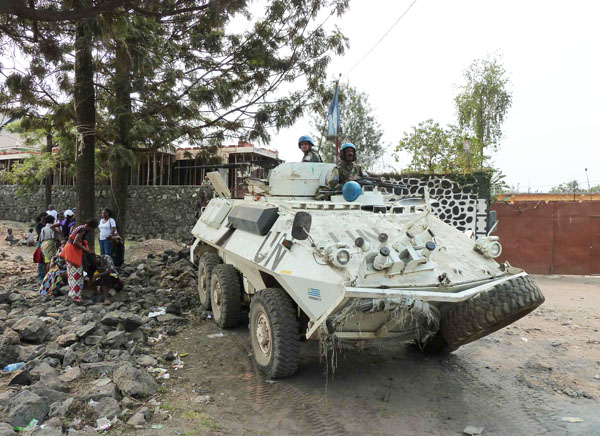
GOMA, Democratic Republic of Congo — Simmering ethnic tensions and frustrations over yet another war and devastation led to a series of attacks and assaults against Rwandaphone-looking people in Goma this week. Students, businesspeople, carpenters, bricklayers, porters, and beggars, mostly from the neighboring city of Gisenyi in Rwanda, but also Congolese nationals, were brutally grabbed off the street by young men, including university students, street boys, and motorbike-taxi drivers.
These vigilantes stopped buses, cars, and motorbikes at spontaneous roadblocks where they were searched for Tutsi-looking people. At the campus of the city’s university and Goma’s main hospital, angry crowds asked for weapons to go and support the weakened FARDC, the Congolese army. Crowds yelled at the victims, some of whom were beaten, to “go back to Rwanda, the invading country!” Parts of the mob amassed at one of the border crossings between Goma and Gisenyi, at what is called “Petite Barrière.” They threw stones in the direction of Rwanda and yelled, “Leave us alone!”
“Our government asked for our help to save our mother country!” the mob chanted. And indeed, the government had called the Congolese nation to mobilize and defeat what it called the threat to the country’s integrity, during a special security meeting chaired by the Congolese Prime Minister Augustin Matata Ponyo Mapon. The statement read, “Given the seriousness of the situation, the government decreed people’s mobilization to defeat the new attempt to destabilize the country, threatening the national territory. The government calls for unity and cohesion of the Congolese people in all of its diversity.” The prime minister said that the enemy is not specific communities but rather “a group of criminals with foreign interests.” While the different ethnic communities have mostly refrained from ethnic violence since the M23 rebellion broke out, some have interpreted the government’s call for popular mobilization as a license to lash out.
The government’s special security meeting took place as the M23 made rapid advances over strategic areas in the Rutshuru territory, North Kivu, where the rebellion has taken hold. Following the fall of Rutshuru town and the city of Kiwanja, where U.N. peacekeepers have a base, the M23 held a public meeting where they proclaimed “peace restored” and called upon displaced people to go home and U.N. peacekeepers to help secure the area. At the same time, they have set up their own police that they claimed would work with MONUSCO to secure civilians, as the rebels entrenched themselves close by in military positions. After the M23 also took control of the Rumangabo military camp, they were reportedly on the move from Tongo and Bambou towards Kichanga and Masisi respectively. Other elements were seen heading towards Ishasha, another border town about 70 km north of Kiwanja town.
In the meantime, the M23 has also installed a political wing called the Policy Coordination, which will be charged with the politics of the movement and the implementation of the 23 March Accord. The coordinator of the political movement, Bishop Jean-Marie Runiga Rugerero, responded to the targeting of Tutsi-looking people on Monday with a threat that the M23 would overrun Goma if necessary to protect the targeted population. But yesterday, the movement’s spokesman, Vianney Kazarama, insisted that the M23 does not intend to take Goma. “We are strong but we are also disciplined," he told AFP.
MONUSCO has stationed armored vehicles at various points in and outside of Goma to secure the city from further unrest and a potential invasion and has brought additional blue helmets to Goma. Yesterday, MONUSCO and the FARDC fired on M23 positions, including Nkokwe and Bukima. These bombardments are meant to prevent all advances of the M23 towards FARDC positions, especially towards Goma, according to Alexandre Essomé, chief of the MONUSCO public information office in Goma, speaking with RFI.
The government is also reinforcing its military capacity by moving a U.S.-trained battalion previously stationed in Oriental Province, where they are tracking the Lord’s Resistance Army, toward the provincial capital. In an attempt to ease tensions, the government on Tuesday declared the day as “ville morte,” meaning that businesses remained closed and most people stayed home.
While the government and the U.N. peacekeeping mission are taking precautions, the danger of Goma being attacked by the M23 is considered low by many analysts in the region. Attacking Goma would be seen as a hardly justifiable attack against the international community considering the strong presence of the U.N., NGOs, and diplomats here. Given the military capacity necessary for such an advance, it would also add suspicion to the existing evidence that Rwanda is supporting the rebellion with manpower, weapons, and ammunition.
Asked about the violent turn the rhetoric surrounding the government’s calls for “mobilization” took in Goma, a senior M23 officer told Enough, “Kinshasa was forcing their hands to come and secure Goma” even though the government knows that the city is less likely to fall to the rebellion than the towns out of Goma.
Photo: Peacekeepers in an armored vehicle positioned in Goma (Enough / Sarah Zingg Wimmer)

